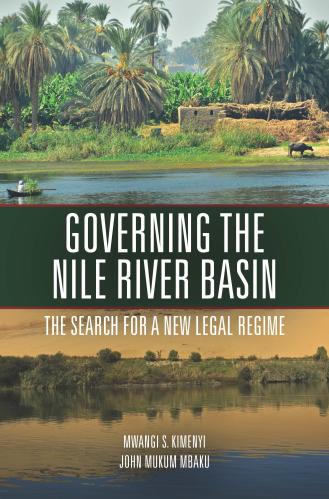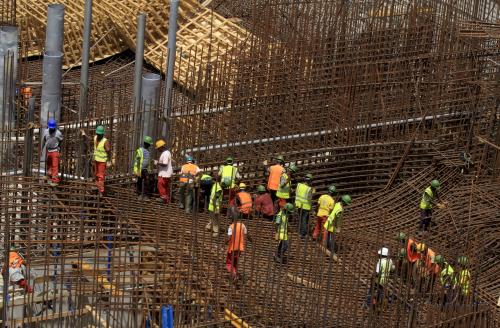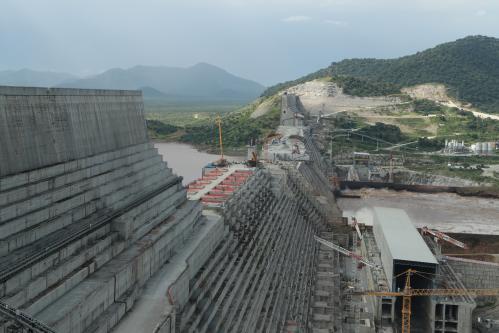This op-ed was originally published by The Africa Report.
The Grand Ethiopian Renaissance Dam (GERD) on the Blue Nile river has become a major point of contention between Ethiopia, Egypt, and Sudan. Ethiopia, which hopes to double its electricity generation capacity through the project, is intent on starting the filling of the dam’s reservoir as early as July 2020.
Egypt, on the other hand, insists that the dam should not go operational before a binding and comprehensive agreement on its filling and long-term operation is reached. Sudan appears to take a middle ground and is helping tame the contention between Ethiopia and Egypt.
Notwithstanding the raging dispute over the dam, Ethiopia, Egypt, and Sudan are expected to face a severe water shortage because of population growth, economic development, and climate change. To alleviate a potentially devastating water crisis, they must redirect their focus from short-term problems to a strategic, long-term cooperation to address the expected shortage through water conservation, economic trade, and technological adoption.
Diplomatic contest
After the Washington-mediated negotiations faltered in mid-February, Egypt and Ethiopia have launched a full-scale diplomatic contest, each seeking support to its own cause. Egypt gained the full support of the Arab League, which passed a resolution that supported the so-called “historic rights” for the waters of the Blue Nile. Egypt then took the case to the United Nations Security Council and Ethiopia responded in kind with its own response and complaint. The Secretary-General of the U.N. has subsequently issued a statement that advised the two countries to resolve their differences at the negotiation table.
The Blue Nile and other tributaries flowing from Ethiopia make up about 86 percent of the water flows of the main Nile. However, the Anglo-Egyptian treaty, initially signed in 1929 between Britain’s colonies Sudan and Egypt, was updated and signed again in 1959 between an independent Sudan and Egypt. The treaty fully apportioned the river’s flow between the two countries, leaving Ethiopia with no share in a major waterbody that represents a vast part of its territory.
Challenging this status quo
With the construction of the GERD, Ethiopia is challenging this status quo, but Egypt worries the dam will reduce the full flow of water. Egypt justifies its claim for the full flow of the Nile by its arid climate, which makes its existence dependent on the river.
Complicating the issue, Ethiopia is facing a burgeoning population and growing economy, and lacks any significant natural resources other than its vast hydropower potential, which is estimated to be 45,000 gigawatts. About two-thirds of this hydropower capacity is located in the Blue Nile basin, but so far only one-tenth of the potential has been utilized.
With nearly two-thirds of its population lacking access to electricity, Ethiopia is keen to develop its water resources to meet its growing energy demand. Moreover, Ethiopia claims that the dam does not directly consume water once the reservoir is filled. After all, hydropower is generated by releasing water downstream at a regulated pace.
Ethiopia’s Blue Nile Dam is hence a point of inflection where the past meets the present, with a potentially significant change of course. For Egypt, this change could entail an abrogation of its age-old claim for a privileged position to virtually all of the Nile water. For Ethiopia, the hydroelectric power project will have a transformative effect on its 64 million citizens who are currently not connected to the electric grid.
This spat between Ethiopia and Egypt should be viewed as a prelude to a future of severe water scarcity in the region, as explosive population growth, economic development, and climate change threaten to plunge the entire basin into a serious water crisis.
According to U.N. data, the population of the 11 Nile Basin countries, which stood at just 83 million in 1950 and 321 million in 2000, is currently 549 million, and is expected to balloon to more than 1 billion by 2050.
Policy measures
Therefore, if water disputes today lead to knotty international legal wrangling, we should expect to encounter sever calamities when water demand increases by multiple folds in the future. Luckily, there is still a lot that can be done to diminish the likelihood of such a scenario if the region is prepared to act now.
1. Nile Basin countries—especially Egypt, Sudan, and Ethiopia—should collaborate and allocate resources for active conservation efforts to reduce desertification and ensure the sustainability of the water systems in the region.
The Nile snakes through the fragile ecosystems of the Sahel and the Sahara, and its watershed has been subjected to severe deforestation and land degradation. It is also botched by new risks such as the recent infestation of water hyacinth, an invasive weed that is threatening to choke up Lake Tana, the source of the Blue Nile.
Downstream countries that depend on the Nile could do more to invest in projects that tackle deforestation, reduce land degradation, and mitigate environmental risks. Sadly, upstream countries with limited resources have been left to their own devices: Even Egypt, which considers itself as a historical steward of the Nile, has done virtually nothing to help preserve its ecosystem. The Nile Basin countries should actively work to coordinate efforts across the full stretch of the Nile to effectively tackle budding environmental problems. This should include increasing electrification to reduce the high level of biomass consumption that fuels deforestation.
2. Serious policy effort is needed to increase the economic and technical efficiency of water usage, especially in agriculture.
Research shows that Egypt, which is the most water-scarce country in the basin, is in fact a net virtual exporter of water, with a net embedded water export of 8.4 billion cubic meters in 2007. Egypt’s virtual water export embedded in its export goods is equivalent to about 10 percent of the flow of the main Nile, and is the result of an inefficient strategy of producing water-intensive products such as feed plants, alfalfa, beans, paddy rice, vegetables, and fruits.
Improving technical efficiency is also crucial: Producing 1 kilogram of maize consumes about 1.12 cubic meters of water per kilogram in Egypt, which is twice greater than the water usage in France. In an ideal world where the value of water is internalized, Egypt could improve its water efficiency to the level of France, or alternatively import maize from France and use the water in other areas where there is greater water efficiency. Instead, maize is the second most important crop in Egypt, being cultivated on 750,000 feddans of land.
If production was organized in a manner that economizes water use, Egyptian farmers would have received incentives to produce less water-demanding products. This is a major issue since Egypt’s population is set to more than double by the end of the century, doubling the demand even as water supply declines due to competition upstream. There is hence a need for policy attention for moving production from agriculture, which currently sustains 55 percent of the population, to other less water-consuming economic sectors. This will necessarily entail taking a risk of being dependent on food imports but would save sizable water resources considering that agriculture currently takes up more than 80 percent of Egypt’s total water consumption.
3. Nile Basin countries should turn to technology to increase freshwater availability.
What the recent water crisis indicates is that the Nile may not be a match for the rising water demand in the region. While the longest and one of the mightiest rivers in the world, the Nile’s water content is relatively small and only a fraction of other major rivers like Congo and Amazon. Even without the construction of any major dams, its flow is likely to fluctuate or decline with rising populations and intensive agricultural use in upstream countries.
For Egypt, which is the most economically strong and yet most water-scarce country in the basin, this could be an opportunity for revising its age-old water security strategy that is centered on the Nile. Just as the U.S. managed to reduce its energy dependence on the Middle East through new technologies that enabled the fracking of shale oil, Egypt too should turn to new technologies to reduce its reliance on the dwindling flows of the Nile.
Egypt is endowed with an abundant solar energy and vast water reserves at the Nubian Sandstone Aquifer, a groundwater reservoir system that is equivalent to 500 years of the Nile River water flow. It also has access to seawater from the Red Sea and the Mediterranean. With rapid cost and efficiency improvements in solar energy technologies, it is only a matter of time before it becomes affordable to build solar-fueled desalination plants to satiate a good share of its growing fresh water needs.
The bottom line
Nile basin countries are engaged in a myopic dispute on water allocation even as climate change and desertification threaten the river’s flow and water demand continues to surge. Unless the countries take early measures to invest in water use efficiency, conservation, and development, there will be a growing risk of water crisis that could undermine peace and security in the region. The riparian countries should work cooperatively with a long-term view and adopt policy and technological innovations to ensure that the region has sufficient water supply to meet the demands of its growing population.










Commentary
Op-edCould the Nile dispute be an opportunity to boost freshwater technology?
June 18, 2020